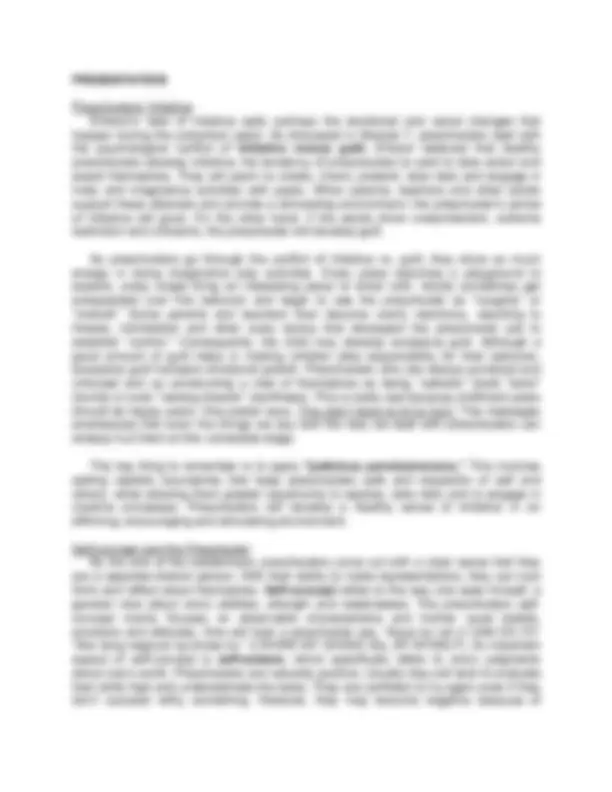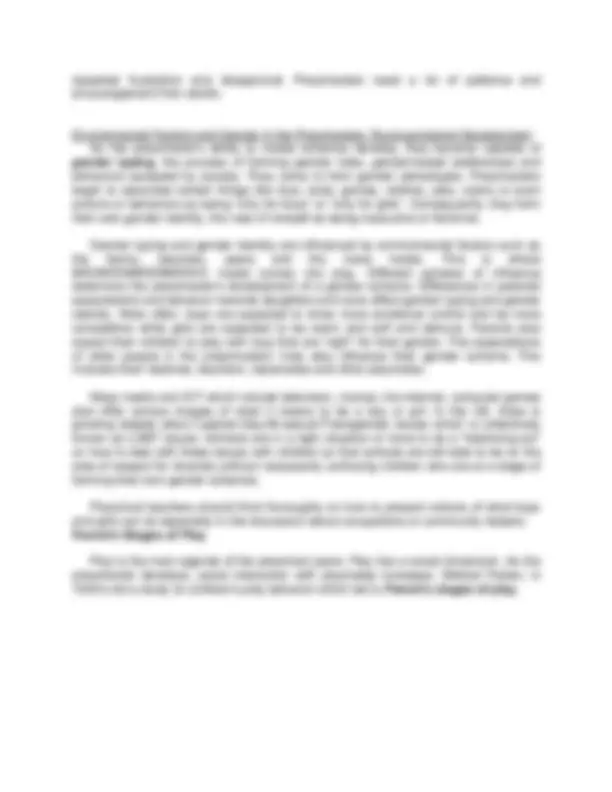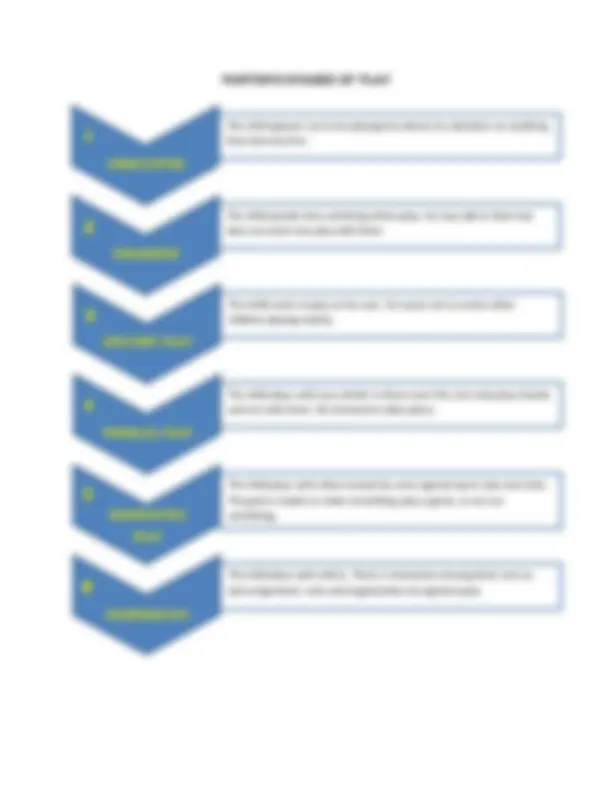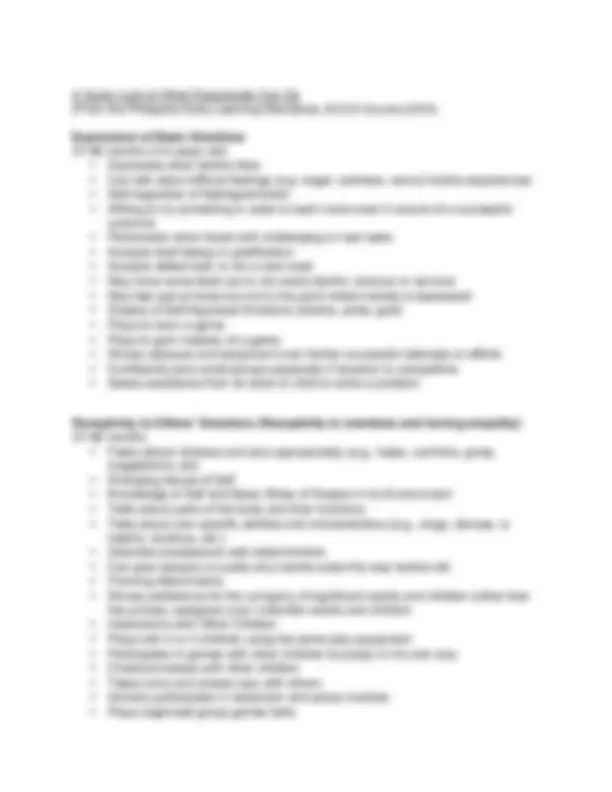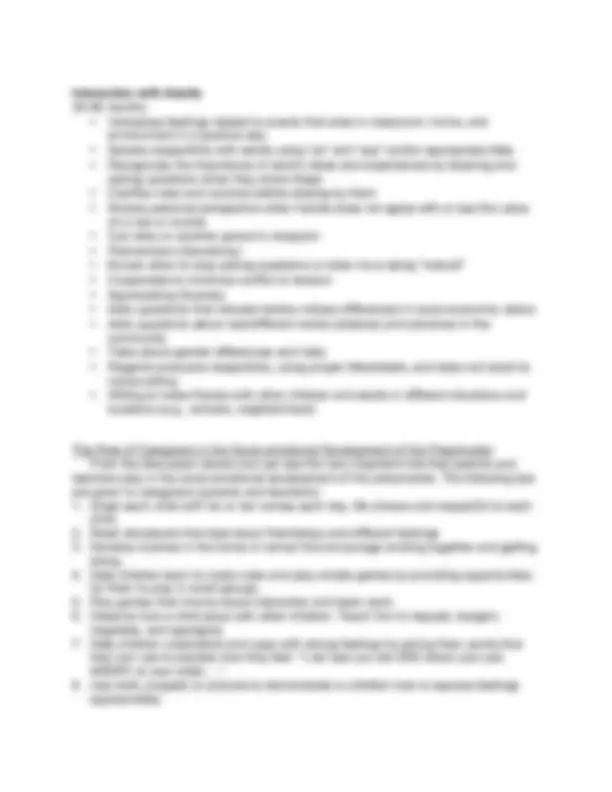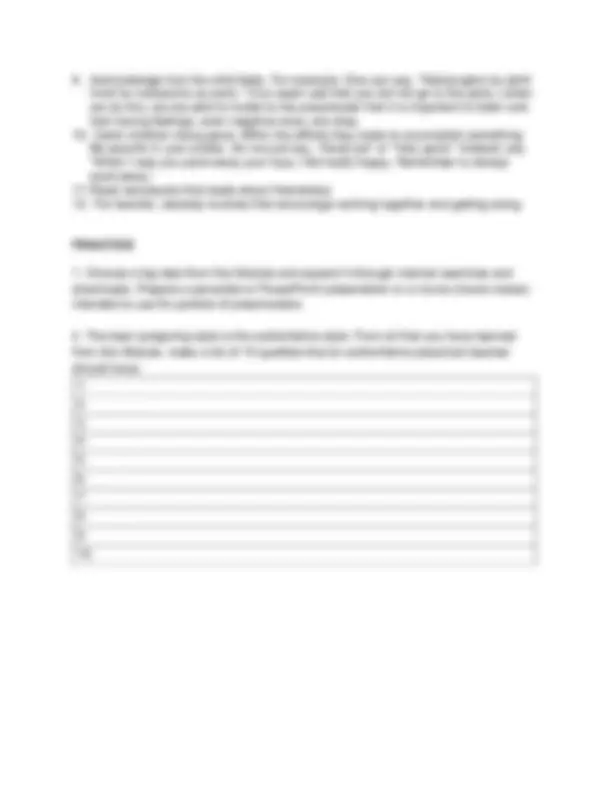Download Module 19 Socio-emotional Development of the Preschoolers and more Lecture notes Human Development in PDF only on Docsity!
MODULE 19 : SOCIO-EMOTIONAL DEVELOPMENT OF THE PRESCHOOLERS
Introduction Socio-emotional development is crucial in the preschool years. We hear a lot of parents and teachers and preschool administrators say that attending preschool is more for “socialization” than for formal academic learning. There is wisdom in this. During the preschool years, children learn about their ever widening environment. Preschooler now discover their new roles outside their home. They become interested to assert themselves as they relate with other people. A lot of very important social skills they will learn during the preschool years will help them throughout life as adults. These skills can even determine the individual’s later social adjustment and con sequent quality of relationships in adult life. In this chapter, you are expected to:
- Analyze the development tasks of early childhood (CLO1);
- Enumerate the ideas on how primary pupils apply concepts in the teaching-learning process (CLO 6);
- Explain Erikson’s “crisis” of early childhood, initiative versus guilt;
- Explain the development of the preschoolers’ sense of self and self-esteem;
- Discuss how children develop gender identity;
- Describe the stages of play and how it impacts socio-emotional development; and
- Discuss the different caregiving styles and their effect on preschoolers. PREPARATION Click the link below and observe the preschoolers. https://www.youtube.com/watch?v=UtrDCBf551o&fbclid=IwAR0LtzINSSNgSQuEOXfUo svbW2it9p3tW1BPO43x7hWGI_xYI4pn3zFFks Note the following:
- Is there a conversation going on? Describe the conversation that takes place among and between the children. What are they talking about?
- Describe what they are playing/what the play is about.
- Describe the children’s interaction. Indicate if they are on their own, working together or if there is conflict. Answer the following questions:
- Were the children playing on their own or alone even when they were with others?
- Were there some children playing together with agreed upon rules and roles? Describe.
- If you observed conflicts between or among children, how were they resolved? Did an adult intervene? Or did they manage to resolve it by themselves?
- Were the children polite? What polite words (Thank you, sorry, etc.) gestures did you observe?
repeated frustration and disapproval. Preschoolers need a lot of patience and encouragement from adults. Environmental Factors and Gender in the Preschoolers ’Socio-emotional Development As the preschooler’s ability to create schemas develop, they become capable of gender typing , the process of forming gender roles, gender-based preferences and behaviors accepted by society. They come to form gender stereotypes. Preschoolers begin to associate certain things like toys, tools, games, clothes, jobs, colors or even actions or behaviors as being “only for boys” or “only for girls”. Consequently, they form their own gender identity, the view of oneself as being masculine or feminine. Gender typing and gender identity are influenced by environmental factors such as the family, teachers, peers and the mass media. This is where BRONFENBRENNERS’S model comes into play. Different spheres of influence determine the preschooler’s development of a gender schema. Differences in parental expectations and behavior towards daughters and sons affect gender typing and gender identity. More often, boys are expected to show more emotional control and be more competitive while girls are expected to be warm and soft and demure. Parents also expect their children to play with toys that are ‘right” for their gender. The expectations of other people in the preschoolers’ lives also influence their gender schema. This includes their relatives, teachers, classmates and other playmates. Mass media and ICT which include television, movies, the internet, computer games also offer various images of what it means to be a boy or girl. In the US, there is growing debate about Lesbian-Gay-Bi-sexual-Transgender issues which is collectively known as LGBT issues. Schools are in a tight situation or have to do a “balancing act” on how to deal with these issues with children so that schools are still able to be on the side of respect for diversity without necessarily confusing children who are at a stage of forming their own gender schemas. Preschool teachers should think thoroughly on how to present notions of what boys and girls can do especially in the discussion about occupations or community helpers. Parent’s Stages of Play Play is the main agenda of the preschool years. Play has a social dimension. As the preschooler develops, social interaction with playmates increases. Mildred Parten, in 1930’s did a study on children’s play behavior which led to Parent’s stages of play.
PARTEN’S STAGES OF PLAY
The child appears not to be playing but directs his attention on anything that interests him.
UNOCCUPIED
The child spends time watching others play. He may talk to them but does not enter into play with them.
ONLOOKER
The child starts to play on his own. He seems not to notice other children playing nearby.
SOLITARY PLAY
The child plays with toys similar to those near him, but only plays beside and not with them. No interaction takes place.
PARALLEL PLAY
The child plays with others bound by some agreed upon rules and roles. The goal is maybe to make something, play a game, or act out
ASSOCIATIVE something.
PLAY
The child plays with others. There is interaction among them, but no task assignment, rules and organization are agreed upon.
COOPERATIVE
Caregiving Style Description The caregivers/parents/teachers with this caregiver style has the following descriptions: Effect on the preschooler Authoritative (high demandingness, high responsiveness )
- Expect behavior appropriate to the age of the child
- Maintain reasonable and their limits
- Closely monitor the activities of the child
- Warm and nurturing
- Have realistic expectations of the child
- Communicate messages in a kind, firm and consistent manner
- Discipline approach focuses more on teaching than punishing
- Set subjective or unreasonable limits
- Communicate messages
- Strive to have strong psychological control punishment, sarcasm, withdrawal of love, threats
- Not able to teach children a better way to behave - Makes the preschooler feel safe and secure - Teaches the child to take responsibility for his/her actions - Develops good self-control - Develops a realistic view of oneself - Builds the child’s capacity for empathy - Lead to aggressive behavior of the child - Brings about poor self- control - Results in poor self-esteem Authoritarian (high demandingness)
- Permit the preschoolers to regulate their own behavior and make their own decisions even when preschoolers are not yet ready to do so
- Do not set rules or very few if any
- Do not demand good behavior or task accomplishment
- May lack confidence in their ability to influence the child
- Maybe disorganized and ineffective in managing the family and household/class
- Shows undemanding, indifferent and rejecting actions towards the child
- Has little commitment to their roles as parents/caregivers
- Maybe depressed or overburdened by many concerns like poverty, marital problems, or absence of support from others
- Has difficulty controlling his/her impulses
- Tends to be independent
- Tends to be demanding Of their caregivers
- Tends not to persist or easily gives up on a task
- Does not easily follow
- Maybe rebellious
- Does not handle frustration well
- Has inadequate emotional control
- Difficulties in school performance When parents’ behavior is to the extreme or if child experiences this style early, the child may have:
- Attachment problems
- Delayed cognitive development
- Poor social and emotional skills
- Delinquent behavior later in adolescence
A Quick Look at What Preschooler Can Do (From the Philippine Early Learning Standards, ECCD Council,2010) Expression of Basic Emotions 37 - 48 months (3-4 years old)
- Expresses what he/she likes
- Can talk about difficult feelings (e.g. anger, sadness, worry) he/she experiences
- Self-regulation of feelings/emotion
- Willing to try something in order to learn more even if unsure of a successful outcome
- Perseveres when faced with challenging or new tasks
- Accepts brief delays in gratification
- Accepts defeat well; is not a sore loser
- May have some fears but is not overly fearful, anxious or nervous
- May feel sad at times but not to the point where he/she is depressed
- Display of Self-Appraisal Emotions (shame, pride, guilt)
- Plays to learn a game
- Plays to gain mastery of a game
- Shows pleasure and enjoyment over his/her successful attempts or efforts
- Confidently joins small groups especially if situation is competitive
- Seeks assistance from an adult or child to solve a problem Receptivity to Others’ Emotions (Receptivity to emotions and having empathy) 37 - 48 months
- Feels others’ distress and acts appropriately (e.g., helps, comforts, gives, suggestions, etc)
- Emerging Sense of Self
- Knowledge of Self and Basic Roles of People in his Environment
- Talks about parts of the body and their functions
- Talks about own specific abilities and characteristics (e.g., sings, dances, is helpful, studious, etc.)
- Describe possessions with determination
- Can give reasons or justify why he/she acted the way he/she did
- Forming Attachments
- Shows preference for the company of significant adults and children (other than the primary caregiver) over unfamiliar adults and children
- Interactions with Other Children
- Plays with 2 or 3 children using the same play equipment
- Participates in games with other children but plays in his own way
- Chats/converses with other children
- Takes turns and shares toys with others
- Actively participates in classroom and group routines
- Plays organized group games fairly
- Acknowledge how the child feels. For example. One can say, “ Nalulungkot ka dahil hindi ka nakasama sa party.” (You seem sad that you did not go to the party.) when we do this, we are able to model to the preschooler that it is important to listen and that having feelings, even negative ones, are okay.
- Catch children doing good. Affirm the efforts they make to accomplish something. Be specific in your praise. Do not just say, “Good job” or “Very good.” Instead, say “When I saw you pack-away your toys, I felt really happy. Remember to always pack-away.”
- Read storybooks that deals about friendships
- For teacher, develop routines that encourage working together and getting along PRACTICE
- Choose a big idea from this Module and expand it through internet searches and downloads. Prepare a pamphlet or PowerPoint presentation or a movie (movie maker) intended to use for parents of preschoolers.
- The best caregiving style is the authoritative style. From all that you have learned from this Module, make a list of 10 qualities that an authoritative preschool teacher should have:
PERFORMANCE
- Research on the following theories on gender development: A. Biological approach B. Psychoanalytic approach C. Cognitive development theory D. Gender schema theory E. Social cognitive theory
- Read on Lesbian, Gay, Bisexual, and Transgender (LGBT) issues. One controversial storybook for children is “Tango Makes Three” a story about two male penguins staring a family. Research on this and write an essay about your own views on introducing LGBT to preschoolers.
- In extreme form, the authoritarian and the negligent caregiving styles can lead to neglect and abuse of the preschooler. Read more on this and share with the class. Reference: Corpuz, Brenda B. et.al., (2018). The Child and Adolescent Learners and Learning Principles. Lorimar Publishing Inc. Cubao, Quezon City. Metro Manila, Philippines.

